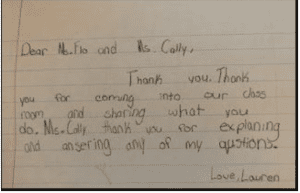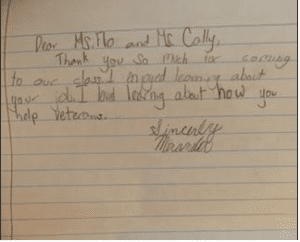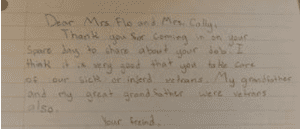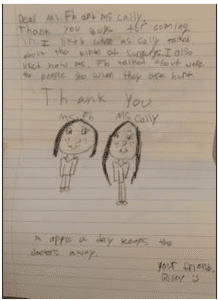We would like to share our experiences as yearly participants in our local Hillsborough County Great American Teach-In (GATI). GATI, an annual November event in the Tampa, Florida area, invites speakers into school classrooms to share information about their professions, including the importance of education to reach the desired career goals. (Although not held in 2020 due to the pandemic, we’re planning to return once the program resumes.)
It all began in 2001 when I (Florence) left my position as an assistant teacher in a health occupations program to return to the hospital setting. My daughter, Cally, was 11 at the time. I still wanted to be involved with the school system and remember how much the students loved GATI. I decided to sign up to visit Cally’s classroom and showcase nursing as a career choice, something I repeated every year until she graduated from high school. I then volunteered at the same elementary school and when Cally graduated from nursing school, she joined me in this endeavor.
As we highlight nursing as a career choice, we always wear our scrubs and stethoscopes and bring gifts for the students from our hospital such as pens and pads. We focus on our nursing careers, and what a typical day is like in our specific areas, inpatient and outpatient. For example, I work in the ambulatory care outpatient setting, and Cally, after 8 years of medical surgical nursing is now an acute care clinical nurse educator.
During our GATI visits, we always focus on staying healthy to avoid becoming sick, which is a goal in the outpatient setting. In the inpatient setting, we focus on preparing for discharge and understanding complicated discharge instructions, which is why education is so important.
We spend a lot of time answering questions about the care of postop patients. The children are very interested in the types of surgery and what’s involved in the recovery period. They are also particularly interested in hearing more about our orthopedic surgery patients as many shared stories of their own experiences with broken bones. The students like to hear what happens after discharge, and we share how outpatient nurses ensure continuity of care, follow up appointments with healthcare providers, and return to baseline activity, including work.
We’re also realistic about the challenges nurses face. We realize that a positive perception of this career choice is a great motivating factor to become a nurse, but that it’s important for students to have a realistic view of the role.
During our last visit, we discussed Cally’s new nursing education position and the gift of teaching others, which is what their teacher does. And we included the many opportunities nurses have to change jobs, such as transitioning from inpatient to outpatient nursing, working in the operating room or an outpatient clinic, for example. Many of the students shared stories of grandparents who had to undergo surgery, including their many challenges and how helpful the nurses were. They also asked excellent questions such as, What made you become a nurse? What if the patient doesn’t feel well when they get home? What if they don’t want to quit smoking? How do surgical incisions look?
Over the last few years, we have now partnered with Cally’s second-grade teacher, who has been a fourth grade teacher for the last 20 years. We have enjoyed going back in time and also working with this age group of 9- and 10-year-olds. We have found that all students are fascinated with a future nursing career and that encouraging healthy life choices such as diet and exercise and regular check ups can improve their own health. This mirrors health promotion, which is what nurses stand for.
Research from Gore and colleagues indicates that having a parent in the nursing profession can also increase a child’s interest in the profession, and we learn every year that many of the students have nurses in their own families, which increases their enthusiasm. During feedback, many of the students imagine nursing as a career option, thinking of it as an opportunity to care for others and make a difference. This is reflected in our yearly letters of gratitude from the students (see below).
We look forward to renewing our visits when we can safely do so.
Letters from students








Cally Graniero is an acute care nurse educator, and Florence Graniero is a staff nurse in ambulatory care at James A Haley Veterans Hospital in Tampa, Florida.
References
Glerean N, Hupli M, Talman K, Haavisto E. Young peoples’ perceptions of the nursing profession: An integrative review. Nurse Educ Today. 2017;57:95-102. doi: 10.1016/j.nedt.2017.07.008
Gore J, Rickards B, Fray L, Holmes K, Smith M. Profiling Australian school students’ interest in a nursing career: Insights for ensuring the future workforce. Aust J Adv Nurs. 2017;35(2):12-22.


















